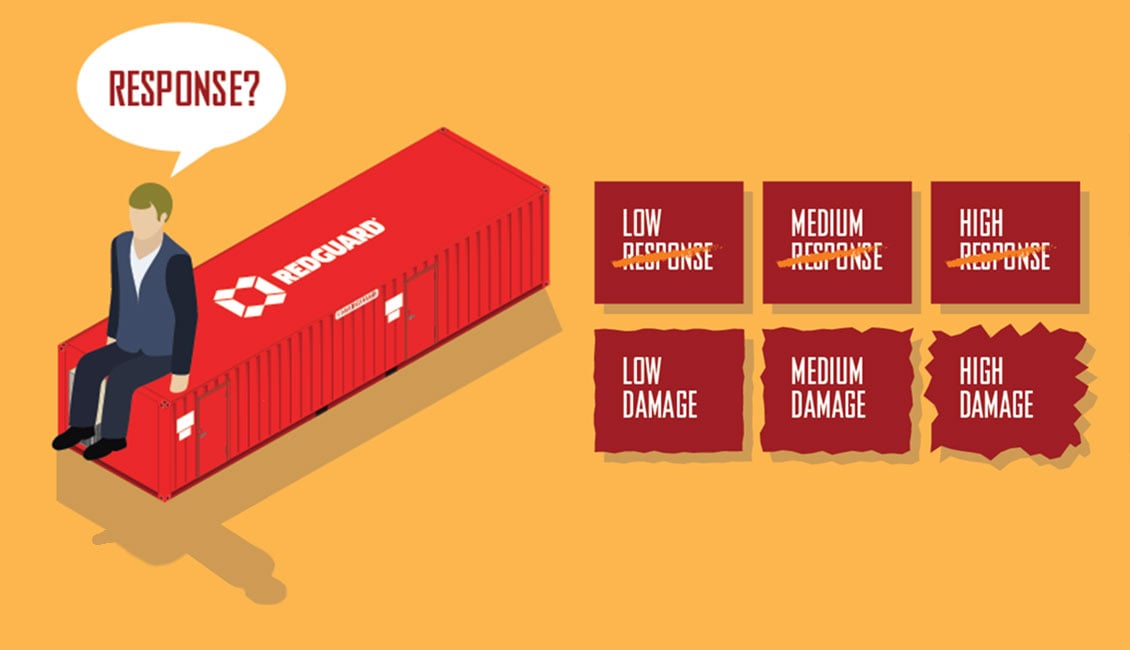Blast-Resistant Building Ratings: Is High Response Acceptable?


 In the blast-resistant building industry, we toss around the term "response level" all the time and assume everyone knows what it means. And maybe everyone here does, but the difference between a low response building and a high response building can mean the difference between life and death, so it's worth a closer look, even if you already know the basics.
In the blast-resistant building industry, we toss around the term "response level" all the time and assume everyone knows what it means. And maybe everyone here does, but the difference between a low response building and a high response building can mean the difference between life and death, so it's worth a closer look, even if you already know the basics.
And, if you don't yet know the basics? it might be a good idea to read up on blast resistant buildings, from cost to common issues, to questions to ask before you buy. We've written the ultimate guide to blast-resistant buildings.
'Response level' equals 'damage level'
Response levels are ratings established by the American Society of Civil Engineers (ASCE) to predict the extent of repair resources that would need to be devoted to a building after an explosion. Their descriptions include:
- Low response — Localized building/ component damage; building can be used, however, repairs are required to restore the integrity of structural envelope; and the total cost of repairs is moderate.
- Medium response — Widespread building/component damage; building cannot be used until repaired; and total cost of repairs is significant.
- High response — Building/component has lost structural integrity; building may collapse due to the environmental conditions; and total cost of repairs approaches replacement cost of building.
Substitute the term "damage level" for "response level," and it gives you an instant picture of what these ratings mean. Given the options of low damage, medium damage and high damage, you obviously don't want to be working in an area that is highly damaged during a blast event.
What to look for in a Blast-resistant Building
Anything worse than medium response is virtually synonymous with injuries and fatalities. And if you plan on using the building to house critical control systems in a petrochemical facility, casualties are only one of many problems you'll face in a high response situation.
-1.jpg?width=400&name=Quad%20Pod%20(6)-1.jpg) There are several blast-resistant building designs on the market. When we were asked by one of the industry's key oil refiners to come up with a new one, our first step was to study what was already out there. It came as a surprise few of the existing designs had received low response ratings from ASCE.
There are several blast-resistant building designs on the market. When we were asked by one of the industry's key oil refiners to come up with a new one, our first step was to study what was already out there. It came as a surprise few of the existing designs had received low response ratings from ASCE.
We hired Ali Sari, Ph.D., PE, who is one of the few experts in the world with firsthand blast response experience. The resulting RedGuard designs were awarded low to medium response ratings, depending on blast pressures.
How did we achieve these response ratings?
The most significant improvement is the placement of steel studs 11- to 12-inches apart rather than several feet apart. This denser stud framework is like a boxer's rib cage, which springs back after taking a punch. If you place too much flat wall surface between studs, the response ratings will rise quickly.
Are regulations in place?
There is no regulatory board for blast resistant building design because the technology is still new. This will probably change, but the closest industry criteria currently in place are the recommended practices provided by API, or American Petroleum Institute.
These design considerations are aimed at meeting specific PSI and duration requirements for specific zone placements, but that only covers two out of three vital criteria. There is still room for confusion when building manufacturers meet the required pressures and durations for specific zones but incorporate a high response level in their design.
What About Blast Testing?
Even with these important guidelines in place, the final proof is in the testing. We detonated 1,250 pounds of high explosive ammonium nitrate/fuel oil charge at a standoff distance of 110 feet from our building. This created a blast strength far in excess of the ratings required to meet ASCE low to medium response standards.
The building suffered no structural damage and neither did the furnishings, office equipment, or the crash test dummy we placed inside. The building is still in use today at the RedGuard headquarters.
This outlines the importance of taking a closer look at both response level ratings and test results before you buy a blast-resistant building. In response to the question, "Is high response acceptable?" for us, that answer will always be a resounding no.
At RedGuard, we manufacture our buildings as if we'll be using them ourselves. If your goal is to protect personnel and resources, you should ask yourself, "Is high response good enough?"
We take pride in being the industry leader in blast resistance and in offering the things we've learned as resources for the industry. If you're about to invest money in a blast-resistant building, take some time to read our guide, offering an in-depth look at blast-resistance and the things you should know before you buy.
To find out more about response levels discussed here, and blast-resistant buildings, talk to one of RedGuard's subject matter experts.
Darren Hillman
Darren Hillman joined RedGuard in February 2009 and is president of the corporation. In his role leading the RedGuard team, he directs the day-to-day operations of the company and is involved in providing strategic direction, leading upper-level management, as well as coaching and counseling teammates. He's also a front-line leader with direct involvement with customers, regulatory bodies, community organizations, and employees.



